Ever felt that twinge of jealousy scrolling through photos of friends dancing in clouds of colored powder? That’s Holi FOMO, and it’s completely justified.
India doesn’t just host festivals; it stages sensory symphonies that redefine celebration. From the luminous nights of Diwali to the elephant parades of Thrissur Pooram, Indian festivals offer experiences that make typical parties look like bland business meetings.
The most incredible Indian festivals blend centuries-old traditions with spine-tingling spectacle. They’re not just photo ops—they’re portals to understanding how over a billion people celebrate life, faith, and community.
But which festivals actually deserve your precious vacation days? And how do you experience them like a local instead of an awkward tourist with a selfie stick?
Diwali: The Festival of Lights
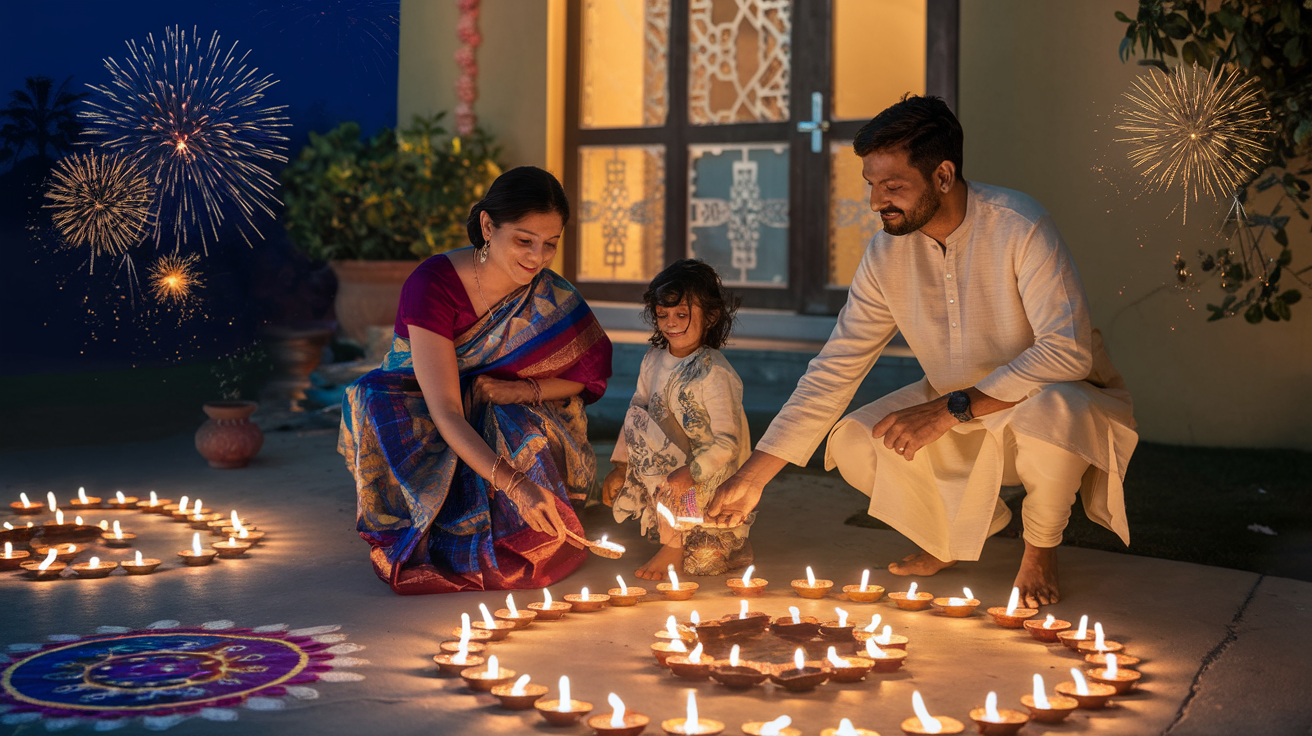
Ancient origins and spiritual significance
Ever wondered why a billion people light up their homes on a moonless night? Diwali isn’t just about spectacular fireworks and sweets that’ll make your taste buds dance.
This ancient festival dates back over 2,500 years. Its roots? The epic Ramayana. When Lord Rama returned to Ayodhya after defeating the demon king Ravana and completing a 14-year exile, people celebrated by lighting clay lamps (diyas) to guide him home through the darkness.
But that’s not the only story behind Diwali. In some regions, it commemorates the day Lord Krishna defeated the demon Narakasura. For others, it’s when Goddess Lakshmi was born from the ocean during the cosmic churning of the milk sea.
At its core, Diwali represents the victory of light over darkness, good over evil, and knowledge over ignorance. Not just religious symbolism—these are powerful life metaphors that resonate with everyone.
Spectacular light displays across India
Nothing prepares you for India during Diwali. Seriously.
Picture entire cities transformed into oceans of twinkling lights. Every home, from humble village huts to grand mansions, adorned with rows of oil lamps and colorful electric lights. Streets become magical pathways lined with marigold flowers and rangoli—intricate colorful patterns drawn with colored powders, rice, or flower petals.
The night sky erupts with fireworks in an unplanned but somehow synchronized symphony of light and sound. In places like Varanasi, the ghats along the Ganges River offer a breathtaking spectacle as thousands of floating diyas create rivers of light.
Regional variations in celebrations
Diwali might be one festival, but India celebrates it in fifty different ways:
- North India: Five-day celebrations including Dhanteras (buying gold/silver), Choti Diwali, Diwali, Govardhan Puja, and Bhai Dooj (celebrating brother-sister bonds)
- West India: In Gujarat, it marks their New Year with account books worship and business renewals
- South India: In Tamil Nadu, people celebrate with oil baths before sunrise, while Kerala focuses on Krishna worship
- East India: Bengal worships Goddess Kali instead of Lakshmi, with dramatic rituals and offerings
Best cities to experience authentic Diwali festivities
Want the full-throttle Diwali experience? These spots won’t disappoint:
- Varanasi: Nothing beats watching thousands of diyas floating down the sacred Ganges during the Dev Deepawali celebration
- Jaipur: The Pink City turns golden with every building illuminated, markets bursting with energy
- Amritsar: The Golden Temple’s reflection in water, surrounded by countless lamps, creates a scene straight out of dreams
- Kolkata: Experience the unique Kali Puja variant with dramatic rituals and incredible food
- Udaipur: The City of Lakes comes alive with palaces glowing against the water
Each location offers its unique flavor of this Diwali festival tradition, making it one of the most captivating Indian festivals to attend.
Holi: The Colorful Celebration of Spring
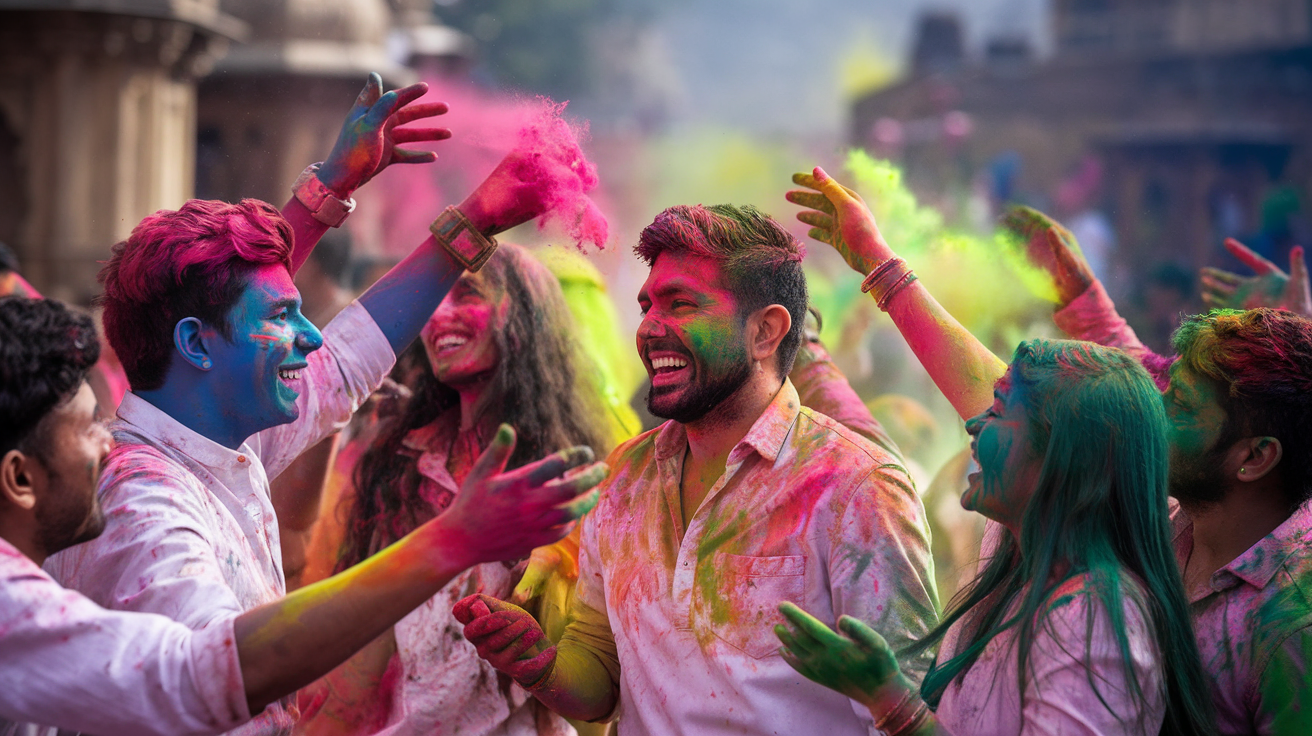
Cultural heritage and mythological stories
Ever wondered why people throw colored powder at each other during Holi? The answer lies in ancient Hindu mythology.
Holi celebrates the victory of good over evil, specifically the story of Prahlad and his evil aunt Holika. When Holika tried to burn Prahlad (who was devoted to Lord Vishnu) in a fire, divine intervention protected him while Holika burned instead. That’s why many communities start Holi with a symbolic bonfire called Holika Dahan the night before.
Another popular myth behind Holi involves mischievous Krishna. Feeling self-conscious about his blue skin compared to fair-skinned Radha, Krishna playfully applied color to her face. This loving gesture evolved into the colorful celebration we know today.
Traditional rituals and modern adaptations
The traditional Holi experience starts with the evening bonfire ritual and continues with “playing colors” the next day. Families gather to smear each other with gulal (colored powder), spray colored water, and share sweets.
But Holi’s modern versions have taken things up several notches:
- Music and dance festivals: Cities now host massive Holi parties with DJs, dancing, and professional color throws
- Organic colors: Traditional chemical-based colors are being replaced with flower and plant-based alternatives
- Water conservation: Many celebrations now limit water usage, focusing more on dry colors
The festival has also gone global. From London to New York, Holi color runs and festivals have become popular cultural events worldwide.
Safety tips for first-time participants
Thinking of joining the rainbow madness? Smart move! But come prepared:
- Apply coconut or olive oil to your skin and hair before playing – it makes color removal much easier
- Wear old clothes you don’t mind ruining (white shows colors best!)
- Protect your eyes with sunglasses and keep your mouth closed when colors are being thrown
- Bring waterproof cases for phones and cameras
- Stay hydrated but only drink from sealed bottles
- Consider using natural colors if you have sensitive skin
Top locations for the most vibrant Holi experiences
Want the authentic Holi experience? These spots deliver the real deal:
- Mathura and Vrindavan: Krishna’s birthplace offers week-long festivities with unique traditions
- Barsana: Experience Lathmar Holi where women playfully beat men with sticks
- Jaipur: Royal celebrations with elephant parades and folk performances
- Shantiniketan: A cultural celebration with Bengali traditions started by Rabindranath Tagore
- Goa: Beach Holi parties that combine traditional elements with modern music
Photography opportunities during the festival
Holi is a photographer’s dream. The explosion of colors against human emotion creates stunning visual stories.
For the best shots, focus on capturing genuine moments – children laughing as they’re doused in color, elderly people participating with youthful joy, or the contrast between color-covered faces and bright smiles.
Early morning light works best for capturing the vivid colors. Position yourself against the sun to catch color throws backlit for that magical effect. And don’t forget to protect your gear with plastic covers or dedicated rain sleeves!
Durga Puja: Bengal’s Grand Celebration
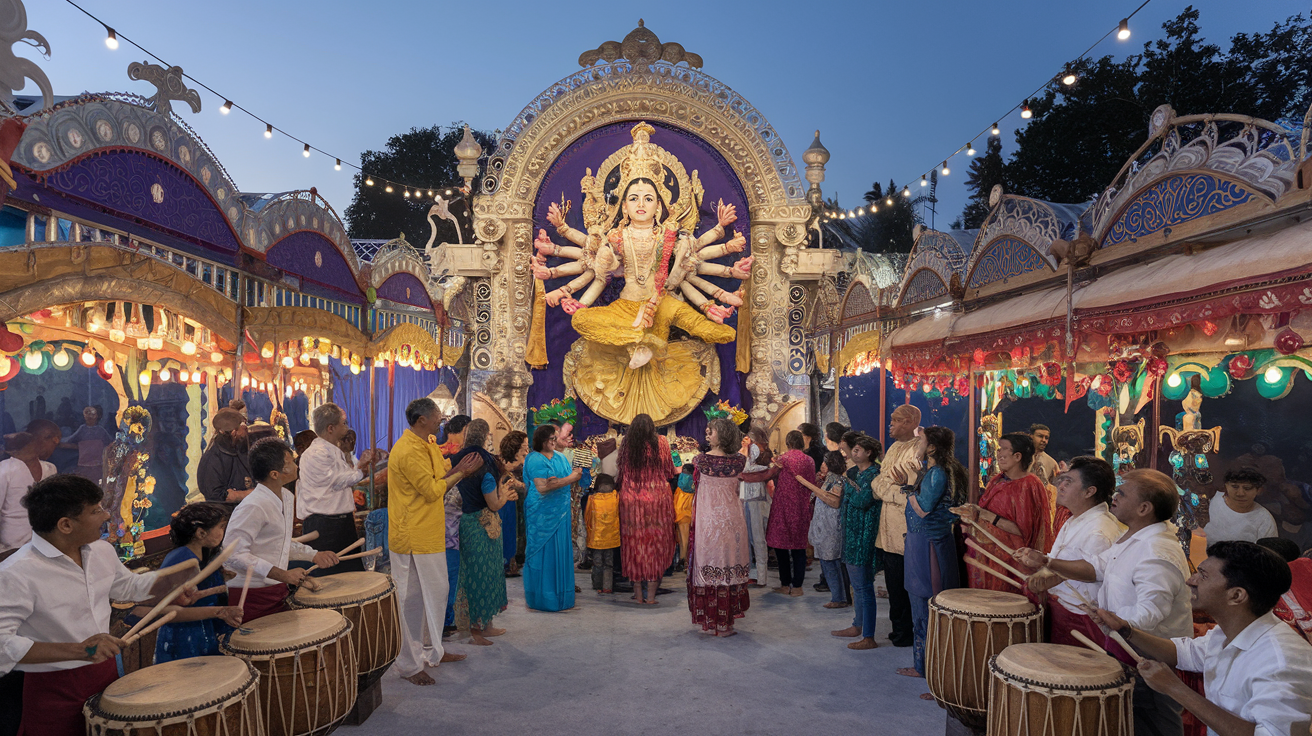
The artistic marvel of pandal hopping
If you haven’t experienced Durga Puja in Bengal, you’re seriously missing out on one of India’s most spectacular cultural showcases. Pandal hopping isn’t just an activity—it’s practically a competitive sport during the best time to visit Durga Puja.
Picture this: every neighborhood transforms overnight into an open-air art gallery. These aren’t your average decorations. We’re talking massive temporary structures that can look like anything from ancient temples to modern architectural wonders. Some even recreate famous landmarks from around the world!
The real magic happens when you join the crowds moving from one pandal to another until the early morning hours. There’s something electric about being part of the throngs of people—dressed in their finest—all admiring these incredible creations together.
What blows my mind every time? The level of craftsmanship. Local artisans spend months designing these masterpieces using materials like bamboo, cloth, and clay. Some pandals cost millions of rupees to create, only to be dismantled after just a few days. Talk about ephemeral art!
Cultural performances not to miss
The pandals are just the beginning of what makes this one of the most traditional Indian cultural festivals. The evenings come alive with cultural performances that showcase Bengal’s rich artistic heritage.
Don’t skip the dhunuchi dance—performers balancing earthen pots with burning coconut shells and incense, dancing to the hypnotic rhythm of the dhak (traditional drums). It’s mesmerizing and unlike anything you’ll see at other must-see festivals in India.
The streets transform into stages where you’ll find:
- Classical dance recitals by renowned performers
- Traditional folk music sessions that go on for hours
- Drama performances retelling mythological stories
- Contemporary fusion music blending Bengali classics with modern beats
Pro tip: Check out College Square and North Kolkata for some of the most authentic cultural performances.
Culinary delights during the festival season
Getting hungry from all that pandal hopping? Durga Puja is as much a food festival as a religious one!
Bengali cuisine shines during these five days. Temporary food stalls pop up everywhere, serving everything from street foods to traditional delicacies. The aromas of frying luchis (puffed bread) and ghugni (yellow pea curry) fill the air.
The bhog (community feast) is the highlight for many. It’s typically served on banana leaves and includes:
- Khichuri (rice and lentil dish)
- Mixed vegetable preparations
- Chutney
- Payesh (rice pudding)
Evening snacking is where it gets interesting. From the crispy phuchka (Bengal’s version of pani puri) to the savory rolls and cutlets—your taste buds are in for a treat.
Even traditionally non-Bengali restaurants roll out special Durga Puja menus featuring Bengali classics. This culinary adventure alone makes Durga Puja worth adding to any Indian festivals to attend list.
Pushkar Camel Fair: Desert Extravaganza
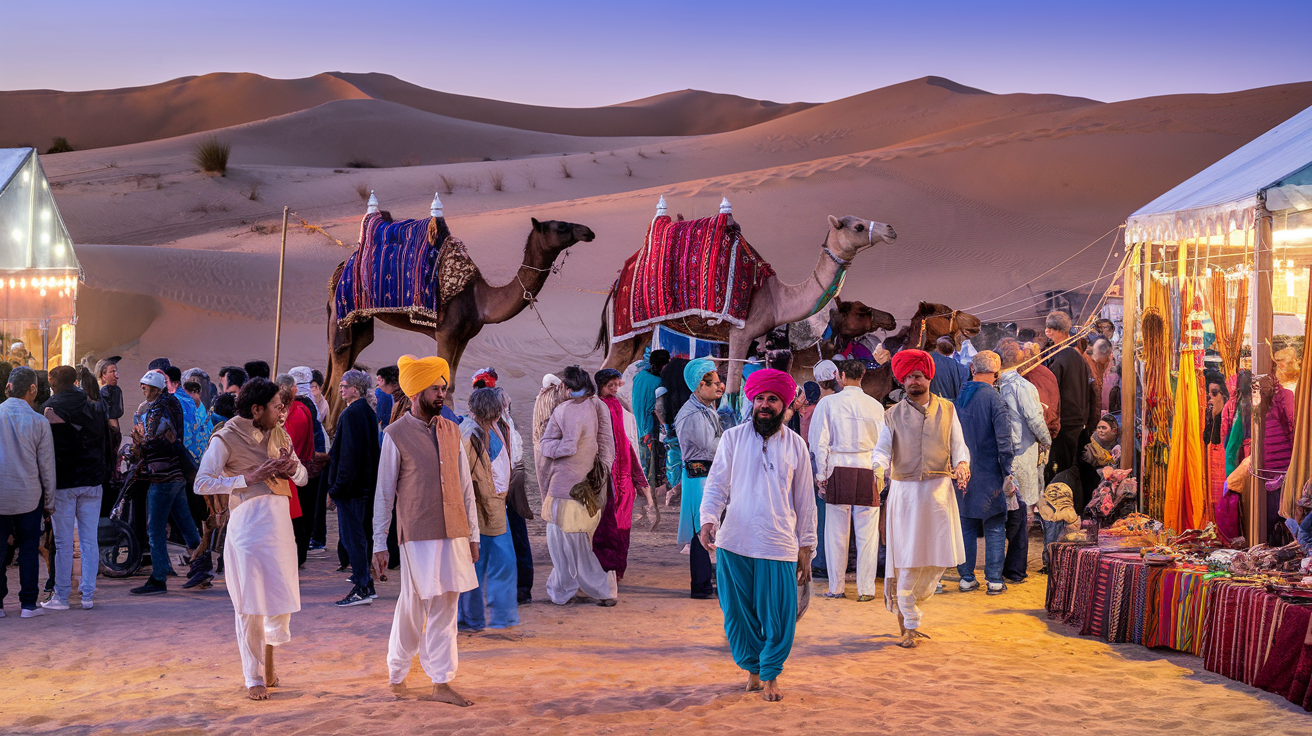
The Stunning Sight of Thousands of Camels
Ever seen 50,000 camels gathered in one place? Trust me, it’s not something you’ll forget. The Pushkar Camel Fair transforms Rajasthan’s golden desert into a living, breathing spectacle that leaves even seasoned travelers speechless.
These aren’t just any camels. They’re decked out in colorful saddles, intricate embroidery, and jingling ornaments. Camel traders journey for days across the Thar Desert, creating this massive gathering that’s equal parts livestock market and cultural phenomenon.
Dawn is pure magic here. The early morning light casts long shadows across the dunes as camel herders prepare their animals, the air filled with dust and anticipation. This isn’t some tourist trap – it’s a centuries-old tradition where serious business happens alongside the festivities.
Cultural Competitions and Traditional Performances
The fair kicks into high gear when the competitions start. Camel races draw huge crowds, with owners proudly showing off their fastest animals. But the real showstopper? The camel beauty contests. Yes, you read that right.
Owners spend months preparing their camels, grooming them meticulously and adorning them with the finest decorations. The judges look for everything from facial features to the elegance of their walk. It’s serious business with major bragging rights at stake.
Nights at Pushkar burst with color and sound. Folk dancers in swirling ghagras perform around bonfires, while musicians play haunting melodies on traditional instruments like the ravanhatta and manjira. The energy is infectious – you’ll find yourself clapping along before you know it.
Hot Air Balloon Experiences Over the Fairgrounds
Want to take your Pushkar Camel Fair experience to another level? Literally? The hot air balloon rides offer the most jaw-dropping views you can imagine.
Floating silently above the fairgrounds at sunrise, you’ll see the vast encampment stretching to the horizon – thousands of tents, camels, and people appearing like miniatures below. The sacred Pushkar Lake glimmers in the distance while the Aravalli hills create a dramatic backdrop.
The balloon operators time the flights perfectly for optimal photography conditions. Just remember to book well in advance – these rides sell out months before the fair.
Photography Tips for Capturing Desert Magic
Getting killer shots at Pushkar requires some insider knowledge. The harsh desert light creates challenges, so shoot during the golden hours – an hour after sunrise or before sunset. The soft light bathes everything in a warm glow that makes colors pop.
Get permission before photographing people, especially women. A smile and a nod go a long way. Offering to show them the image afterward often breaks the ice.
For those epic wide-angle shots of camel herds, climb the surrounding hills in the early morning. Bring a zoom lens for portraits and a wide-angle for the sweeping desert landscapes.
Don’t just chase the obvious shots. Some of the most compelling images come from quiet moments: hands preparing chai, children playing between tents, or the weathered face of an elderly camel trader counting his earnings.
Here is a travel plan for visiting the Pink City of Jaipur.
Onam: Kerala’s Harvest Festival
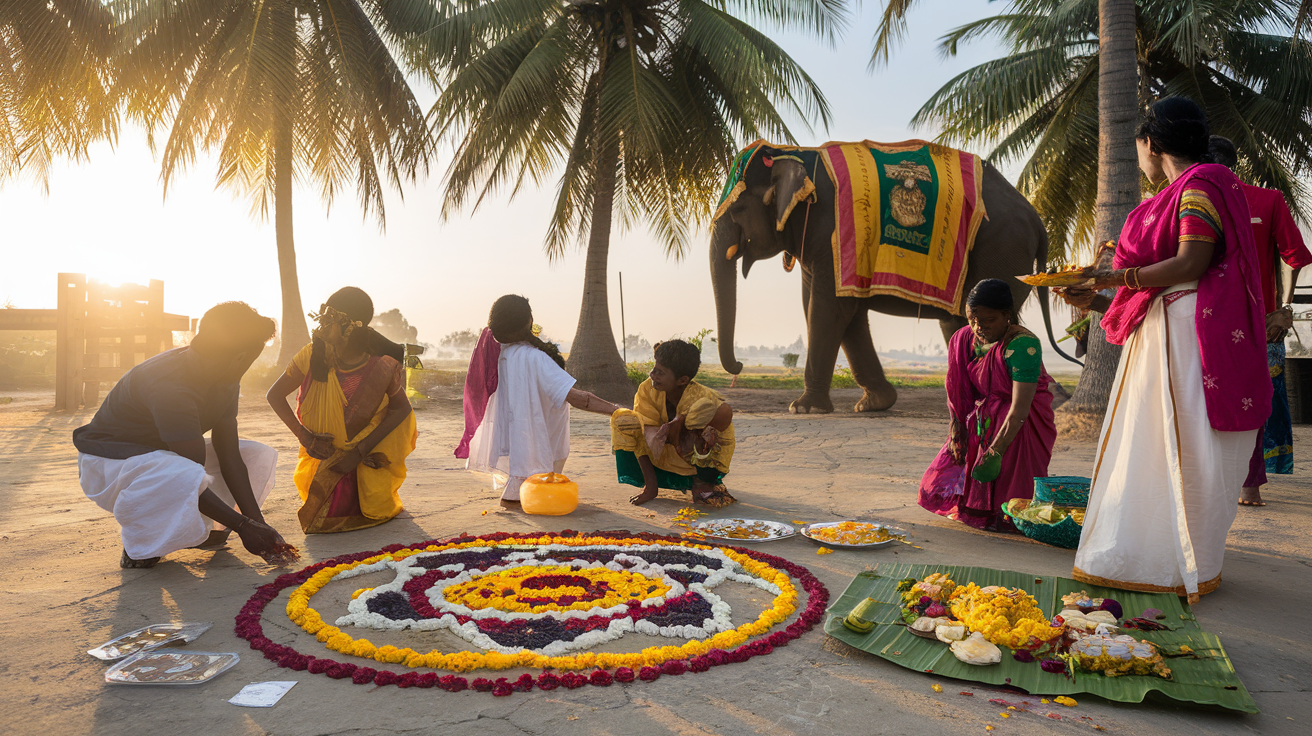
The spectacular snake boat races
Ever seen 100+ rowers moving in perfect sync on a 100-foot boat adorned with gold? If not, you’re missing out on one of Kerala’s most breathtaking sights during Onam.
The Vallam Kali (snake boat races) aren’t just races – they’re a heart-stopping display of teamwork, strength, and centuries-old tradition. Imagine massive boats cutting through Kerala’s backwaters while thousands cheer from the shores. The energy is absolutely electric.
During the Onam festival, these races transform sleepy backwater villages into buzzing centers of excitement. Crews train for months to compete, with each village rallying behind their team. The boats themselves are works of art – sleek, black-hulled vessels with raised sterns that curve upward like cobra heads.
What makes these races truly unforgettable isn’t just the boats but the synchronized chanting of the rowers. Their rhythmic “vanchipattu” (boat songs) echo across the water, creating a hypnotic backdrop to the visual spectacle.
Intricate flower carpets (pookalams)
Walk through Kerala during Onam and you’ll spot stunning works of art right beneath your feet. Pookalams – intricate flower carpets – decorate every home’s threshold, from humble cottages to luxury hotels.
These aren’t simple flower arrangements. They’re complex mandalas requiring serious skill and patience to create. Families wake before dawn to gather fresh blooms in ten specific colors, from vibrant orange marigolds to delicate white jasmine.
What’s fascinating about pookalams is how they grow more elaborate each day of Onam. Starting with a simple circular design on Atham (the first day), layers and patterns are added daily until the final, most spectacular carpet appears on Thiruvonam, the festival’s climax.
The real beauty? Despite hours of painstaking work, these masterpieces are temporary – a powerful reminder of life’s impermanence in Hindu philosophy.
Traditional Onam Sadhya feast
The Onam celebration reaches its peak around a banana leaf – specifically, the grand Onam Sadhya feast that would make any foodie weak at the knees.
This isn’t just dinner. It’s a culinary marathon featuring 26+ dishes served in a specific order on a fresh banana leaf. The contrasts are magical – crispy papadums against creamy yogurt curry, sweet jaggery-infused banana chips following fiery pickles, and at least four different rice preparations.
The Sadhya follows strict rules. Dishes are placed in particular positions on the leaf, eaten in a specific sequence, and – here’s the kicker – consumed only with your right hand (no utensils allowed). It’s sensory overload in the best possible way.
What truly sets the Kerala Onam festival apart is how this feast brings people together. Communities gather regardless of religion or status, sitting cross-legged in rows, sharing this epic meal as equals – the perfect embodiment of the inclusive spirit this harvest festival celebrates.
For a plan to experience the best of Kerala, visit Kerala in 8 days.
Ganesh Chaturthi: Maharashtra’s Beloved Festival
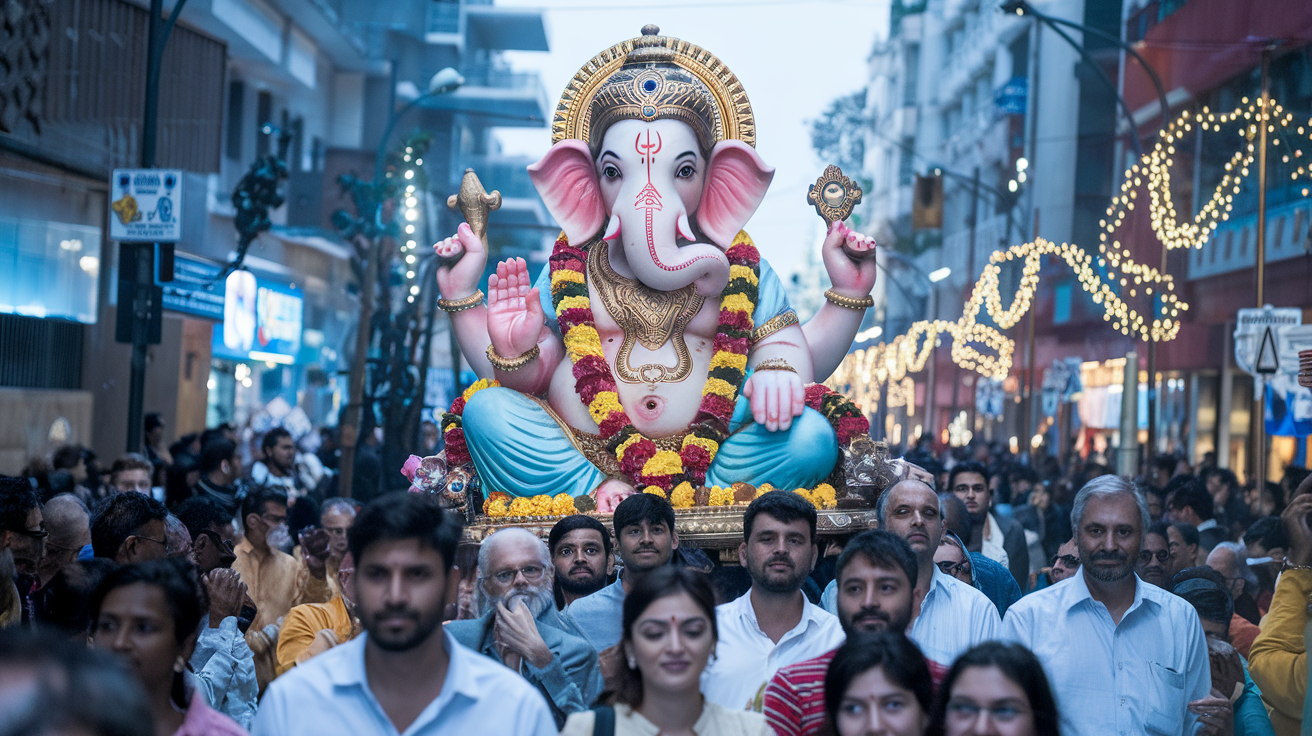
The magnificent Ganesh idols across Mumbai
Mumbai explodes with creativity during Ganesh Chaturthi. Seriously, you haven’t seen anything until you’ve witnessed the towering Ganesh idols that transform this city’s landscape every year. Some stand over 20 feet tall, meticulously crafted by artisans who work for months to perfect every detail.
The Lalbaugcha Raja is the superstar of them all. This iconic idol draws millions—yes, millions—of devotees who wait in line for 24+ hours just for a quick darshan (viewing). The energy there? Absolutely electric.
But don’t just stick to the famous ones. The real magic happens when you explore the neighborhood pandals where local communities pour their hearts into their creations. In Dadar and Parel, you’ll find idols that tell stories from mythology with stunning artistic flair.
What makes these idols truly special isn’t just their size but the themes they represent. Many showcase current social issues or celebrate Indian heritage. Last year, one pandal recreated an entire ancient temple complex around their Ganesh idol!
Procession routes worth witnessing
The immersion processions (visarjan) are where the real party happens. Girgaum Chowpatty Beach becomes the epicenter of festivities on the final day, with thousands of idols making their way to the Arabian Sea.
The best spots to catch the action? Park yourself near Marine Drive around sunset. You’ll see hundreds of processions converging, with drums beating, people dancing, and chants of “Ganpati Bappa Morya” filling the air.
For a more intimate experience, head to Juhu Beach or Versova Beach where local community processions create a more personal celebration. The smaller processions often allow visitors to join in—just ask politely!
Pro tip: The 5th and 7th day processions are less crowded but equally vibrant.
Environmental initiatives transforming the celebration
Gone are the days when all Ganesh idols polluted waterways. A fantastic eco-revolution is sweeping through the festival.
More artisans now create clay idols that dissolve harmlessly in water, replacing the harmful plaster of Paris versions. The Sprouts Environmental Trust has been pioneering artificial immersion tanks where idols can be immersed without harming natural water bodies.
Even the decorations are getting greener. Many pandals now use natural materials like bamboo, jute, and cloth instead of plastic and thermocol. Some innovative communities have even created biodegradable decorations that can be composted after the festival.
The BMC (Brihanmumbai Municipal Corporation) has set up dedicated immersion spots with proper waste management systems. They’ve also introduced incentives for eco-friendly celebrations.
Community participation opportunities
Want to dive into the festivities yourself? You absolutely can!
Many pandals welcome volunteers to help with crowd management, serving prasad (blessed food), or assisting elderly visitors. Just approach the pandal committee members a few days before the festival begins.
For those interested in the artistic side, workshops teaching idol-making pop up across the city in the weeks before the festival. The Kala Ghoda Arts Festival often hosts special Ganesh-themed art classes.
If you’re a photographer, this festival is pure gold. Just remember to be respectful when capturing images, especially during prayers.
Nagaland’s Hornbill Festival: A Tribal Extravaganza

Rich cultural showcase of 16 tribes
Ever wondered what it’s like when 16 distinct tribal communities gather to celebrate their heritage? That’s exactly what the Hornbill Festival delivers.
This 10-day cultural extravaganza in Nagaland isn’t just another Indian festival – it’s a living museum where the state’s 16 major tribes come together in an explosion of color, tradition, and pride. Nicknamed the “Festival of Festivals,” it’s held every December in Kisama Heritage Village, just a short drive from Kohima.
Each tribe gets its own traditional morung (communal hut) where they showcase their distinctive customs, outfits, and way of life. The contrast is striking – one tribe might sport elaborate headdresses adorned with hornbill feathers, while another displays intricate body tattoos that tell stories of their warrior past.
The Hornbill Festival Nagaland is your one-stop destination to witness centuries of preserved traditions that would otherwise require months of difficult travel through remote mountain villages.
Traditional dance and music performances
The rhythm of log drums will grab you first. Then the hypnotic tribal chants pull you in deeper.
The festival grounds come alive with performances that’ll make you forget about your Instagram feed for a while. Warriors perform the Konyak war dance with such intensity you can almost feel the ancient battlefield energy. Meanwhile, the Angami tribe’s peaceful harvest dances offer a complete contrast – gentle, flowing movements that honor the earth’s bounty.
What makes these performances special isn’t just their cultural authenticity but the genuine pride on the performers’ faces. These aren’t staged shows for tourists; they’re living traditions passed down through countless generations.
Warrior displays and indigenous games
Think you’re tough? Wait till you see Naga warriors in action.
The festival features impressive demonstrations of traditional warfare tactics, spear throwing, and archery. The highlight for many visitors is watching the fierce-looking warriors, with their face paint and headgear adorned with hornbill feathers, perform mock battles that showcase lightning-fast reflexes and spectacular jumps.
Indigenous games offer everyone a chance to participate. Try your hand at bamboo pole climbing or test your aim in traditional archery competitions. The crowd favorite is often Naga wrestling – a sport where technique beats brute strength and winners earn serious bragging rights in their villages.
Authentic tribal cuisine experiences
Prepare your taste buds for an adventure unlike any other at the traditional food stalls.
Each tribe brings their culinary specialties, many featuring ingredients you won’t find anywhere else in India. Sample smoked pork with axone (fermented soybean), bamboo shoot curry, or if you’re feeling adventurous, try the traditional rice beer called zutho served in bamboo containers.
Communal feasting is central to the festival experience. Join locals around fires as they cook and share stories – there’s no better way to understand a culture than breaking bread together.
Handcrafted souvenirs to bring home
The craftsmanship of Naga tribes will leave you speechless.
Artisans display their skills in weaving, woodcarving, metalwork, and pottery throughout the festival. Each item tells a story – from shawls with designs indicating specific tribes and achievements to intricate cane baskets that can last generations.
The most coveted souvenirs are the traditional Naga necklaces featuring colorful beads, animal teeth, and brass medallions. Each piece is completely unique, making them perfect mementos of this unforgettable cultural immersion.
Among traditional Indian cultural festivals, the Hornbill Festival stands out as not just a must-see festival in India, but a genuine opportunity to witness living heritage before modernization changes it forever.
For imemrsive culture walks in india, visit 5 Senses Walks.
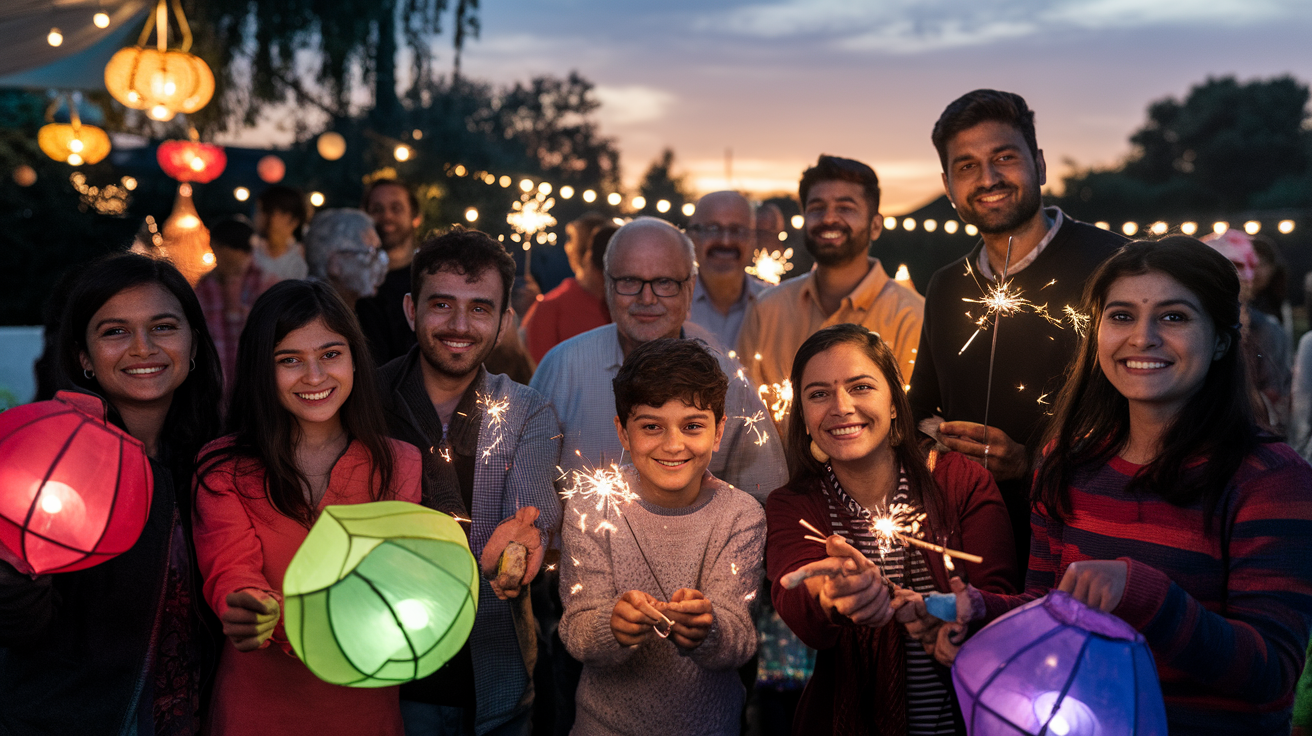
India’s festival calendar offers a spectacular array of cultural experiences that showcase the country’s incredible diversity. From the shimmering lights of Diwali to the vibrant colors of Holi, the majestic celebration of Durga Puja, the unique Pushkar Camel Fair, Kerala’s beautiful Onam, the devotion of Ganesh Chaturthi, and the tribal traditions of the Hornbill Festival—each celebration represents a unique facet of India’s rich heritage.
Planning your trip around these festivals will transform your Indian journey from a simple vacation to an unforgettable cultural immersion. Whether you’re drawn to religious celebrations, cultural performances, or simply the joyous atmosphere that pervades the country during these special times, these seven festivals promise experiences that will remain with you long after you’ve returned home.
If you want to know about Indian street food, check the Ultimate guide to Indian street food.
Discover more from Great Holiday Ideas
Subscribe to get the latest posts sent to your email.